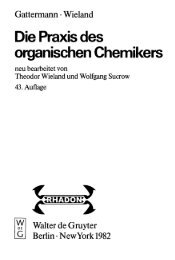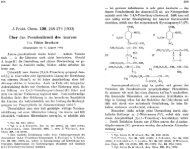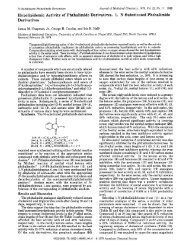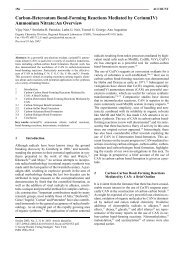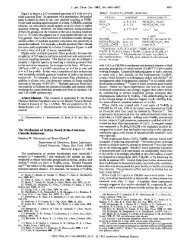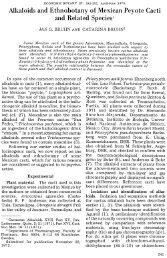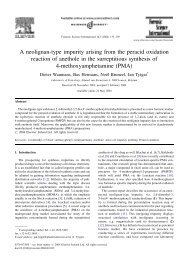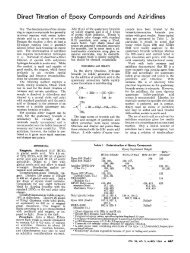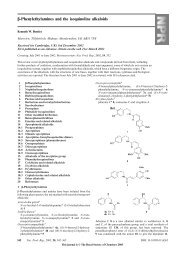Preparation of Nitriles from Halides and Sodium Cyanide ... - mdma
Preparation of Nitriles from Halides and Sodium Cyanide ... - mdma
Preparation of Nitriles from Halides and Sodium Cyanide ... - mdma
Create successful ePaper yourself
Turn your PDF publications into a flip-book with our unique Google optimized e-Paper software.
THE JOURNAL OF Organic<br />
Volume 25, Number 6<br />
Chemistry<br />
0 Copyright 1960<br />
by the American Chemical Society<br />
[COSTRIBUTIOS FROM THE DEPARTMENT OF CHEMISTRY, THE OHIO STATE UNIVERSITY ]<br />
June 9, 1960<br />
<strong>Preparation</strong> <strong>of</strong> <strong>Nitriles</strong> <strong>from</strong> <strong>Halides</strong> <strong>and</strong> <strong>Sodium</strong> <strong>Cyanide</strong>. An Advantageous<br />
Nucleophilic Displacement in Dimethyl Sulfoxide'"<br />
L. FRIEDMANlb ASD HAROLD SHECHTERio<br />
Received October 9, 1959<br />
Reaction <strong>of</strong> primary <strong>and</strong> secondary chlorides with sodium cyanide in dimethyl sulfoxide occurs rapidly <strong>and</strong> efficiently to<br />
result in an improved general method for preparing nitriles. Advantages are also realized in conversion <strong>of</strong> primary <strong>and</strong><br />
secondary bromides to their corresponding nitriles. Use <strong>of</strong> dimethyl sulfoxide allows preparative displacement <strong>of</strong> halides <strong>of</strong><br />
the neophyl <strong>and</strong> neopentyl types by cyanide ion without rearrangement. Typical procedures which illustrate the various<br />
experimental methods are described.<br />
<strong>Sodium</strong> or potassium cyanide reacts slowly dimethylformamide. 4b,6 Primary bromides are con-<br />
(twenty-four to ninety-six hours) with primary verted efficiently to nitriles in aqueous ethanol7a or<br />
chlorides in aqueous ethanol to give the correspond- ethylene glycol (better). 3,7b Secondary bromides,<br />
ing nitriles in good yields, accompanied by alcohols, however, in aqueous ethanolsa or ethylene glycol3<br />
ethers, <strong>and</strong> olefins.2 The procedure is unsatisfactory give nitriles in unsatisfactory (27-39%) yields, <strong>and</strong><br />
for low boiling nitriles3 because <strong>of</strong> the difficulty <strong>of</strong> separation <strong>of</strong> the product <strong>from</strong> accompanying alcoisolating<br />
the products <strong>from</strong> the solvent. The method hols <strong>and</strong> ethers is difficult.sb<br />
has been improved by use <strong>of</strong> higher boiling solvents It is now reported that typical primary chlorosuch<br />
as ethylene glycol,3 methyl Cell~solve,~"~~ alkanes (Table I) react rapidly <strong>and</strong> exothermicallyg<br />
tetrahydr<strong>of</strong>urfuryl <strong>and</strong> dimethylforma- with sodium cyanide in partial solution in dimethyl<br />
mide;4b however, the reaction is still slow because sulfoxide to give the corresponding nitriles in ex<strong>of</strong><br />
the insolubility <strong>of</strong> the inorganic cyanides <strong>and</strong> cellent yields. The nitriles are conveniently isolated<br />
<strong>of</strong>fers disadvantages for the usual laboratory syn- <strong>from</strong> the reaction mixture by dilution with water folthesis.<br />
Secondary chlorides give nitriles in only 30% lowed by suitable extraction. At the preferred reacyield<br />
in aqueous ethanol;6 substitution also occurs tion temperatures <strong>of</strong> 120-140" the conversion <strong>of</strong><br />
slowly <strong>and</strong> in poor yield in methyl Cellosolve <strong>and</strong> primary chlorides to nitriles may usually be com-<br />
(1) (a) Abstracted in part <strong>from</strong> the Ph.D. Dissertation <strong>of</strong><br />
L. Friedman, The Ohio State University, 1959. (b) Present<br />
address: Department <strong>of</strong> Chemistry, New York University,<br />
University Heights, N. Y. (c) To whom inquiries should be<br />
pleted in one half to two hours. The reaction is applicable<br />
to the slow conversion <strong>of</strong> 1-chloro-2-methyl-<br />
2-phenylpropane(neophyl chloride) lo to 3-methyl-3made.<br />
(2) (a) H. B. Hass <strong>and</strong> J. R. Marshall, Ind. Eng. Chem.,<br />
23, 352 (1931); (b) H. E. Fierz-David <strong>and</strong> W. Kuster,<br />
Helv. Chzm. L4cta, 22, 82 (1939); (c) H. Suida <strong>and</strong> F. Drahowzal,<br />
Chem. Ber., 75, 991 (1942); (d) K. Ahmad <strong>and</strong> F.<br />
M. Strong, J. Am. Chem. SOC., 70, 1699 (1948); (e) K.<br />
Ahmad, F. 31. Bumpus, <strong>and</strong> F. M. Strong, J. -4m. Chem.<br />
(6) 2-Chlorobutane does not react with sodium cyanide<br />
in ethylene glyc01.~<br />
(7) (a) C. S. Marvel <strong>and</strong> E. hI. McColm, Org. Sijnlheses,<br />
5, 103 (1925); (b) F. B. LaForge, N. Breen, <strong>and</strong> W. A.<br />
Gersd<strong>of</strong>f, J. Am. Chem. Soc., 70,3709 (1948).<br />
(8) (a) 31. T. Rogers <strong>and</strong> J. D. Roberts, J. Am. Chem. SOC.,<br />
68, 843 (1946); (b) T. Moritsugu, M.S. Thesis, The Ohio<br />
SOC., 70,3393 (1948).<br />
(3) R. 3. Lewis <strong>and</strong> P. V. Susi, J. Am. Chem. SOC., 74,<br />
840 (1952).<br />
(4) (a) A. 0. Rogers, U. S. Patent 2,415,261, Feb. 4,<br />
1947; (b) H. €3. Copelin, U. S. Patent 2,715,137, Aug. 9,<br />
1955.<br />
(5) Ref. 2a; no experimental details were given.<br />
State University, 1951.<br />
(9) Cooling is sometimes required to keep the reaction<br />
under control.<br />
(10) <strong>Halides</strong> <strong>of</strong> the neopentyl type are reported to be<br />
unreactive to cyanide ion; A. Franke, Monatsh. Chem.,<br />
34, 1893 (1913); F. C. Whitmore <strong>and</strong> G. H. Fleming, J. Am.<br />
Chem. SOC., 55,4161 (1933).<br />
877
878 FRIEDMAN ASD SHECHTER VOL. 25<br />
phenylbutyronitrile (69% conversion, 29% yield').<br />
The secondary chloro compounds, 2-chlorobutane<br />
<strong>and</strong> chlorocyclopentane (Table I), react relatively<br />
slowly (ca. three hours) to give the corresponding<br />
nitriles in moderate yields (6,5-70%). As a general<br />
method for preparing nitriles <strong>from</strong> primary or sec-<br />
ondary chlorides, the reaction in dimethyl sulfoxide<br />
is much superior to that in the previous solvents.<br />
&Butyl chloride <strong>and</strong> cyclohexyl chloride in di-<br />
methyl sulfoxide react either in the presence or<br />
absence <strong>of</strong> sodium cyanide to give olefins, malo-<br />
dorous decomposition products, <strong>and</strong> tars. l1 Benzyl<br />
chloride gave the corresponding nitrile (Table I)<br />
in excellent yield. Better yields <strong>of</strong> benzyl cyanide<br />
were obtained at lower temperatures because re-<br />
action between the halide <strong>and</strong> the solvent was<br />
minimized. l2 p-Nitrobenzyl chloride reacted with<br />
sodium cyanide in dimethyl sulfoxide to give 4,4'-<br />
dinitrostilbene. l3<br />
The reaction <strong>of</strong> sodium cyanide <strong>and</strong> alkyl halides<br />
was extended to representative bromides.14 1-Rro-<br />
mobutane reacts rapidly at 60-90" with sodium<br />
cyanide to give valeronitrile in excellent yield<br />
(Table I). The reaction is exothermic <strong>and</strong>, if the<br />
temperature is too high (>go"), the yield is low-<br />
ered because <strong>of</strong> reaction <strong>of</strong> the halide with the sol-<br />
vent .l5,I6 2-Rromobutane reacts to give 2-methylbu-<br />
tyronitrile in 41% yield. The reaction mixtures are<br />
dark brown <strong>and</strong> noxious; the relatively poor yield<br />
<strong>and</strong> the complex products probably result <strong>from</strong><br />
REACTION<br />
SODIUM<br />
TABLE I<br />
OF *kLKYL dND CYCLOALKYL HALIDES WITH<br />
OR POTASSIUM CYANIDE IX DIMETHYL<br />
1 -Chlorobutane'<br />
1-Chlorobutane'<br />
1-Chloro-2-methylpropane1-Chloro-3-methylbutanel-Chloro-2-methyl-2phenylpropane'<br />
Benzyl chloride<br />
p-Nitrobenz yl<br />
chloride<br />
2-Chlorobutane<br />
2-Chlorobutane<br />
Chlorocyclopentane'<br />
Chlorocyclohexane '<br />
2-Chloro-2-methylpropane<br />
1-Bromobutanen<br />
1-Bromo-2-methylpropanec<br />
2-Bromobutane<br />
SULFOXIDE<br />
Reac- Reaction<br />
tion Yield <strong>of</strong><br />
Halide <strong>Cyanide</strong>a<br />
Temp., Time,<br />
' hr.b<br />
Kitrile,<br />
%<br />
NaCN 140 0 25 93<br />
KCN 120-140 10 69<br />
KaCS<br />
XaCS<br />
Sac?;<br />
NaCN<br />
NaCS<br />
NaCX<br />
KCN<br />
NaCN<br />
KaCS<br />
XaCN<br />
SaCN<br />
XaCX<br />
NaCX<br />
140d 0 5<br />
100-110 2<br />
120 24<br />
35-40' 2 5<br />
35-40 1<br />
120-145 3<br />
120-138k 24<br />
125-130 3<br />
130-80 4<br />
130-105 4<br />
60-90n 0 6<br />
TO 2<br />
70 6<br />
a The ratio <strong>of</strong> halide (moles), cyanide (moles), <strong>and</strong><br />
DMSO (ml.) usually used was 1:1.1:250. The reaction<br />
time listed is the sum <strong>of</strong> that for addition <strong>of</strong> the halide<br />
<strong>and</strong> subsequent reaction at the given temperature. See<br />
Experimental. The halide was added in 10 min. to the<br />
initial mixture at 80'. The reaction is mildly exothermic<br />
<strong>and</strong> was completed by heating to 140' until refluxing<br />
ceased. e B.p. 128", n'," 1.3926; see ref. 23. B.p. 151-155',<br />
(11) (a) These results are consistent with current substi- n: 1.4047-1.4051; lit. b.p. 150-155', H. Rupe <strong>and</strong> K.<br />
tution theory, the results in related systems, <strong>and</strong> the effects Glena, Helu. Chim. Acta, 5, 939 (1922). 0 The reaction mix<strong>of</strong><br />
ionizing solvents on such halides. (b) C. K. Ingold, ture was cooled externally. B.p. 90.5-91' (5 mm.), n:<br />
Structiire <strong>and</strong> Mechanism in Organic Chemistry, Cornel1 1.5237-1.5238; lit. b.p. 115-120' (10 mm.), n'," 1.5242; J.<br />
University Press, Ithaca, X. Y., 1953, p. 319, 426. (c) J. D. W. Bruhl, 2. physik Chem., 16, 218 (1895). 4,4'-Dini-<br />
Roberts <strong>and</strong> V. C. Chambers, J. Am. Chem. Soc., 73, 5034 trostilbene is formed in 78y0 crude yield, m.p. 286-288';<br />
(1951). (d) S. Smith <strong>and</strong> J. Takahashi, unpublished work as lit. 288'; P. Ruggli <strong>and</strong> F. Lang, Helu. Chim. Acta, 21, 42<br />
quoted in ref. 12b.<br />
(1938); R. Walden <strong>and</strong> A. Kernbaum, Chem. Ber., 23,<br />
(12) Reactions <strong>of</strong> halides with dimethyl sulfoxide have 1959 (1890). 1 B.p. 123.5-124' (742 mm.), n'," 1.3898been<br />
investigat,ed by (a) R. Kuhn <strong>and</strong> H. Trischmann, 1.3900; lit. b.p. 125'; M. Hanriot <strong>and</strong> L. Bouveault, Bull.<br />
-4nn., 611, 117 (1958); (b) S. G. Smith <strong>and</strong> S. Winstein, SOC. chim. France, (3) 1, 172 (1889). ' The halide was added<br />
Tetrahedron, 3, 317 (1058) <strong>and</strong> (c) N. Kornblum, W. J. dropwise in 6 hr. to the mixture at 120-125'; the mixture<br />
Jones, <strong>and</strong> G. J. Anderson, J. Am. Chem. SOC., 81, 4113 was then heated for 18 hr. until it reached 138'. The<br />
(1959) <strong>and</strong> related previous paper.<br />
reaction mixture became dark <strong>and</strong> gave cyclohexene, gases,<br />
(13) This reaction also occurs with cyanide ion in ethanol. <strong>and</strong> a black intractable product. Upon initiating reaction<br />
Its mechanism has been discussed by C. R. Hauser, W. R. at 130', gases (2-methylpropene, hydrogen cyanide, <strong>and</strong><br />
Brasen, P. S. dkell, S. TI'. Kantor, <strong>and</strong> A. E. Brodhag, J. formaldehyde) were evolved, the temperature dropped to<br />
.4m. Ch,em. Soc., 78, 1653 (1956) <strong>and</strong> G. Hahn, Chem. Ber., 105", <strong>and</strong> black resinous materials were formed. The de-<br />
62,2485 (1029).<br />
sired product was not obtained at lower reaction tem-<br />
(14) Reaction <strong>of</strong> 1-bromobenaocyclobutene with sodium peratures. The bromide was added in 30 min. to the cyacyanide<br />
in dimethyl sulfoxide to give l-cyanobenaocyclo- nide mixture at 60' while effecting cooling <strong>of</strong> the reaction;<br />
butene has been reported by our colleagues, M. P. Cava, the mixture was then heated for 15 min. at 90'. ' B.p. 138-<br />
R. L. Lit,tle: arid D. R. Napier, J. Am. Chem. SOC., 80, 2260 139" (742 mm.), n'," 1.3970; see Ref. 19. Upon addition<br />
(1958). Their use <strong>of</strong> dimethyl sulfoxide was based on sug- <strong>of</strong> the 2-bromobutane, the temperature was maintained at<br />
gestions anti experimental details <strong>of</strong> prior observations by 55-60" by intermittent cooling. In subsequent reaction<br />
the present authors (Nov. 26-Dec. 21, 1955) on t.he advanta- gases were evolved <strong>and</strong> the mixture became progressively<br />
geous use <strong>of</strong> the solvent in eflecting conversions <strong>of</strong> chlorides darker <strong>and</strong> malodorous.<br />
<strong>and</strong> bromides to nitriles. The absence <strong>of</strong> any reference resulted<br />
<strong>from</strong> the fact that knowledge <strong>of</strong> tjhe unpublished<br />
method was so common in this laboratory that it had as- competing reactions with dimethyl sulfoxide. The<br />
sumed routine use. NOTE ADDED IS PROOF: R. A. Smiley yield with the secondary bromide is slightly supe<strong>and</strong><br />
C. Arnold, J. Org. Chem., 25, 257 (1960) have also rior, however, to those reported when ethanol <strong>and</strong><br />
described the advantageous use <strong>of</strong> dimethyl sulfoxide in ethylene glycol are used as solvents, <strong>and</strong> there are<br />
preparing nitriles <strong>from</strong> alkyl chlorides.<br />
(15) In the absence <strong>of</strong> sodium cyanide, extensive reaction experimental advantages in terms <strong>of</strong> reaction rate<br />
<strong>of</strong> the bromide occurs with the solvent; see ref. 12. <strong>and</strong> isolation <strong>of</strong> products.<br />
88e<br />
85l<br />
26<br />
92h<br />
Oi<br />
64j<br />
42<br />
70<br />
01<br />
Om<br />
92'<br />
62<br />
4lP
JUNE 1960 PKEP.IRATIOS OF SITRILES 879<br />
The reaction <strong>of</strong> alkyl chlorides <strong>and</strong> bromides with<br />
potassium cyanide in partial solution in dimethyl<br />
sulfoxide is Qf significance with respect to prepara-<br />
tive purposes in that displacement occurs much<br />
more slowly when compared with sodium cyanide.I7<br />
The reason for this difference was not investigated.<br />
The synthesis <strong>of</strong> nitriles <strong>from</strong> halides <strong>and</strong> cyanides<br />
was also attempted in dimethylformamide, sulfo-<br />
lane, <strong>and</strong> dimethyl sulfolane. Because the yields<br />
are lower <strong>and</strong> longer reaction times are required,<br />
these solvents are not as advantageous as dimethyl<br />
sulfoxide.<br />
(Potassium cyanide). 1-Chlorobutane (93 g., 1.0 mole) was<br />
added dropwise in 2 hr. to a stirred suspension <strong>of</strong> potassium<br />
cyanide (70 g., 1.06 moles) in dimethyl sulfoxide (250 ml.)<br />
maintained at 120-125'. The mixture was then heat,ed until<br />
the pot temperature rose to 140" (8 hr.) <strong>and</strong> refluxing<br />
ceased. The dark-brown evil-smelling mixture was diluted<br />
with water <strong>and</strong> worked up as described in the preceding experiments<br />
to give a small forerun (4.0 g., b.p. 110-138") <strong>and</strong><br />
valeronitrile (57.5 g., 0.69 mole, 69%), b.p. 138-139' (747<br />
mm.).<br />
Reaction qf 1-chloro-2-methyl-2-phenylpropane <strong>and</strong> sodium<br />
cyanide. 3-Methyl-3-phenylbutyronitrile. A stirred mixture <strong>of</strong><br />
l-chloro-2-methyl-2-phenylpropane (neophyl chloride, 84.39<br />
g., 0.5 mole, b.p. 110-112" (12 mm.), ny 1.5216), sodium<br />
cyanide (40.0 g., 0.82 mole) <strong>and</strong> dimet,hyl sulfoxide (250<br />
ml. j was heated at 120' for 24 hr. The resulting dark-brown<br />
EXPERIMENTAL'^ mixture was cooled, diluted with water <strong>and</strong> xvorked up for<br />
I<br />
product. Rectification gave l-chloro-2-methyl-2-phenylpro-<br />
Reaction <strong>of</strong> 1-chlorobulane <strong>and</strong> sodium or potassium cyanide. pane (28.0 g., 0.163 mole, 32.6y0; b.p. 115-135' (18 mm.),<br />
Valeronitrile. (<strong>Sodium</strong> <strong>Cyanide</strong>). 1-Chlorobutane (93 g., I ny 1.5216-1.5200) <strong>and</strong> 3-methyl-3-phenylbulyronitrile (14.1<br />
mole) was added in 10-15 min. to a rapidly stirred partially- g., 0.089 mole, 26% yield, 690j0 conversion <strong>of</strong> neophyl chlosoluble<br />
mixture <strong>of</strong> sodium cyanide (53 g., 1.08 moles, Rea- ride), b.p. 135-137" (18 mm.), ng 1.5130-1.5132. The physgent)<br />
in dimethyl sulfoxide (250 ml., technical: Stepan ical constants <strong>of</strong> an analytical sample are b.p. 136" (IS<br />
Chemical Company) at 80". The temperature <strong>of</strong> the mix- mm.), ny 1.5130.<br />
ture rose rapidly <strong>and</strong> was kept at 140 f 5' by cooling with Anal. Calcd. for CIlHl3S: N, 8.80. Found: S, 8.83.<br />
water when necessary. During the reaction the mixture be- 'I he structure <strong>of</strong> the 3-methyl-3-phenylbutyronitrile was<br />
came more fluid, <strong>and</strong> the insoluble salts more crystalline. confirmed by its conversion (99%) to 3-methyl-3-phenyl-<br />
After the 1-chlorobutane had been added, the temperature butyric acid, m.p. 54-56', by saponification in refluxing<br />
dropped rapidly, <strong>and</strong> the reaction was apparently complete. aqueous ethylene glycol (12 hr.) <strong>and</strong> subsequent acidifica-<br />
The brown reaction mixture was cooled, diluted with water t,ion; m.p. 58-59' (<strong>from</strong> carbon tetrachloride-hexane); lit.,*O<br />
to a volume <strong>of</strong> ea. 1000 ml., <strong>and</strong> extracted with ether (3 x m.p., 58-59.5'. The mixed melting point with an authentic<br />
150 ml.). The pale yellow ether extracts were rashed with sample was undepressed.<br />
6S hydrochloric acid (to hydrolyze the small amount <strong>of</strong> Reaction <strong>of</strong> chlorocyclopentane <strong>and</strong> sodium cyanide. Cyclonoxious<br />
isocyanide) <strong>and</strong> water, <strong>and</strong> dried over calcium peatunecarbonitrile. Chlorocyclopentane (210 g., 2.0 moles)<br />
chloride. After removal <strong>of</strong> ether, the residue was rectified was added in 20 min. to a stirred mixture <strong>of</strong> sodium cyanide<br />
over phosphorus pentoxide to give forerun (6.0 ml.), b.p. (110 g., 2.25 moles) in dimethyl sulfoxide (530 ml.) at 115'.<br />
110-138' (747 mm.), <strong>and</strong> valeronitrile (77 g., 0.93 mole, The reaction was mildly exothermic. The mixture was heated<br />
930j0), b.p. 138-139" (747 mm.), ny 1.3970-1.3972; lit., at 125-130" for 3 hr. <strong>and</strong> low boiling material began to reb.p.<br />
140.75°,19a n'," 1.3990.1gb<br />
flux. A portion was collected <strong>and</strong> identified as cyclopen-<br />
In a similar manner, 1-chlorobutane (465 g., 5 moles), tene, b.p. 44-46', n'," 1.4208; lit.,21 b.p. 44.24', ny 1.4224.<br />
sodium cyanide (95% purity, 265 g., 5.5 moles) <strong>and</strong> dimethyl The dark-brown react,ion mixture was cooled <strong>and</strong> worked<br />
sulfoxide (475 ml.) gave valeronitrile (388 g., 4.7 moles), up for product. Rectification gave cyclopentanecarbonitrile<br />
b.p. 138-139'. in 94% yield. In large runs the relative volume (133 g., 1.4 moles, 70%), b.p. 74-74.5' (28 mm.), ny<br />
<strong>of</strong> dimethyl sulfoxide was thus lowered.<br />
1.4429; lit.% b.p. 74.5-75' (30 mm.), ny 1.4404.<br />
Reaction <strong>of</strong> 1-bromo-&methylpropane <strong>and</strong> sodium cyanide.<br />
(16) T. Dougherty, Ph.D. Thesis, The Ohio State Uni-<br />
S-Methylbutyronitrile. 1-Bromo-2-methylpropane ( 137 g.,<br />
versity, 1959 has found that 1,3-dibromo-2,2-dimethylpro-<br />
1 mole) was added in 20 min. t,o a warm (60') stirred mixpane<br />
(neopentyl dibromide) reacts with equivalent amounts ture <strong>of</strong> sodium cyanide (55 g., 1.12 moles) in dimethyl sulf<strong>of</strong><br />
sodium cyanide in dimethyl sulfoxide in 66 hr. at 90- oxide (400 ml.); the temperature m-as maintained between<br />
95" to give 4-bromo-3,3-dimethylbutanenitrile (23% con-<br />
55 <strong>and</strong> 60" by intermittent cooling. <strong>Sodium</strong> bromide began<br />
version) <strong>and</strong> 2,2-dimethyl-l,3-propanedinitrile (26-30% to gel near the end <strong>of</strong> the addition. The mixture was then<br />
conversion). The initial dibromide recovered ranged <strong>from</strong> maintained at 70" for 2 hr. to allow completion <strong>of</strong> the reac-<br />
35-50y0. The details <strong>of</strong> this experiment will be published tion. During this period gases were evolved <strong>and</strong> the mixture<br />
elsewhere.<br />
became progressively darker <strong>and</strong> malodorous. lsolation <strong>of</strong><br />
(17) (a) In using potassium cyanide with chlorides, the the product in the usual manner gave 3-methylbutyronit,rile<br />
temperature <strong>of</strong> the mixture had to be maintained above (51 g., 0.615 mole, 62y0), b.p. 128" (743 mm.), nF 1.3927;<br />
120" in order to effect reaction. Low boiling halides thus lit.,22 b.p. 128-129".<br />
had to be added dropwise to a heated mixture <strong>of</strong> potassium When the reaction was effected at 90-loo", more l-bromocyanide<br />
in dimethyl sulfoxide at a rate such that the tem- 2-met8hylpropane react,ed with diniet'hyl sulfoxide, <strong>and</strong> the<br />
perature is not significantly lowered. (b) <strong>Sodium</strong> <strong>and</strong> po- yield <strong>of</strong> nitrile dropped to 48$&.<br />
tassium cyanides are appreciably soluble in warm DMSO; COLUMBVS 10, OHIO<br />
the actual solubilities at various temperatures were not<br />
determined.<br />
(20) F. C. Whitmore, C. A. Weissgerber, <strong>and</strong> A. C. Sha-<br />
( 18) The preparative examples described are representa- bica, Jr., J. Am. Chem. Soc., 65,1471 (1943).<br />
tive <strong>of</strong> the venous experimental procedures summarized in (21) Selected Values <strong>of</strong> Properties <strong>of</strong> Hydrocarbons, API<br />
Table I.<br />
Research Project 44, 1958, Table 5%.<br />
(19) (a) G. Lievens, Bull. SOC. chem. Belges, 33, 126 (22) H. Rupe <strong>and</strong> E. Hodel, Helv. Chim. Acta, 7, 1023<br />
(1924); (b) S. Sugden, J. Chem. Soc., 125, 1186 (1924). (1924).




